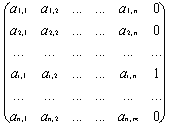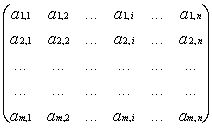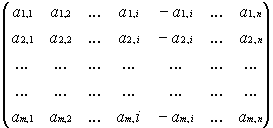Notes on Linear Programming
Dr. John Travis
(Adapted from http://ford.ieor.berkeley.edu/riot/Tools/InteractLP/)
Linear optimization consists in trying to find the optimal value (maximal
or minimal value, depending on the problem) of a linear function of a certain
number of variables (usually labeled x1, x2, ...xn),
given a set of m linear constraints on these variables (equalities or inequalities).
Even if it may seem quite theoretical in a first approach, linear optimization
has a lot of practical applications in real problems. Especially, it is
often used in industry, governmental, organizations, ecological sciences...to
minimize objectives functions (that can be production costs, numbers of
employees to hire, quantity of polluants relessed) given a set of constraints
(availability of workers, of machines, ...).
Linear programming consists in solving the linear problems mentioned
above, and developing the algorithms and software able to find the optimal
solution to a problem, if there is one, or to prove that no solution exists
if that is the case.
Each problem in Linear Optimization can differ in terms of the objective
function (the objective can be either to minimize or maximize a function),
as well as in terms of the linear constraints (equality constraints, inequality
constraints, smaller or equal, strictly smaller...). The Linear Program
is then usually converted into its standard form.
The generic linear program is formulated as follows:
| Minimize c1x1 + c2x2 +.....+
cnxn (Objective function) |
Subject to:
| 1st constraint: |
a1,1x1+ |
a1,2x2+ |
....+ |
a1,nxn= |
b1 |
| 2nd constraint: |
a2,1x1+ |
a2,2x2+ |
....+ |
a2,nxn= |
b2 |
| ... |
... |
... |
... |
... |
... |
| ... |
... |
... |
... |
... |
... |
| m-th constraint: |
am,1x1+ |
am,2x2+ |
....+ |
am,nxn= |
bm |
| |
|
|
|
|
|
| Positivity: |
x1>0 |
x2>0 |
... |
xn> 0 |
|
Or, using vectors and matrices:
| Min CX |
|
| Subject to: |
 |
| where X > 0 |
|
| and C such that |
(c1, c2, ...cn) |
Conversions needed:
-
Conversion of "less than" inequalities into equalities.
-
Conversion of "greater than" inequalities into equalities.
-
Non positive variables.
-
Maximization problems.
Conversion of "less than" inqualites to equalities
Suppose that the kth constraint is a smaller than equality labeled
as follows:
ak,1x1+ak,2x2+... +ak,mxm
<
bk
It is equivalent to say that, for some value xm+1,
ak,1x1+ak,2x2+... +ak,mxm+xm+1=bk
where xm+1, is a positive variable know as a slack variable.
So, we must consider a new column-vector X=(x1, x2,
... , xn )t. To incorporate this into the original
problem, add a column to matrix A with zeros everywhere except on the kth
line (where we will put a 1, so as to include the xm+1 in the
kth constraint), so that A becomes:
Further, we must add a column to vector C (simply one zero, since the new
slack variable, xm+1, must not affect the value of the objective
function) so that C becomes
(c1, c2, ..., cn, cn+1)
where cn+1=0.
So we have a new problem, with the same n constraints, but m+1 variables.
If we repeat this process with all the "smaller than" inequalities, and
introduce one slack variable for each of them, then we obtain a new problem
where all the "smaller than" inequalities are replaced by equalities.
Conversion of "greater than" inqualites to equalities
Suppose that the kth constraint is a bigger than equality
labeled as follows:
ak,1x1+ak,2x2+... +ak,mxm
>bk
It is equivalent to say that, for some value xm+1,
ak,1x1+ak,2x2+... +ak,mxm-xm+1=bk
with xm+1 a positive slack variable. Proceed in a manner
similar to above to modify A and C.
Conversion of non-positive variables
You have certainly noticed that the standard formulation of a linear program
is quite restrictive, since it does only consider positive variables. In
reality, it does not constitute a problem, since we can easily convert
a problem where some variables are not required to be positive into a problem
with only positive variables.
Indeed, suppose that the kth variable xk
has no positivity constraint. We the introduce two "artificial variables":
x'k and x''k and replace xk by xk
= x'k - x''k. So, we can still have xk
either positive or negative, with x'k and x''k positive.
The new variable column-vector is
(x1, x2, ... , x'k, x''k,
... , xn )t.
where x'k and x''k positive.
This duplication of variable xk into two variables
obliges us to update matrix A and vector C:
-
In matrix A, we add a new column labeled A'.,i between
columns k and k+1, equal to the opposite of the original column k.
So A, that was equal to
becomes
And we will have, in each constraint j:
ak,jx'k+a'k,jx''k = ak,j(x'k-x''k)
= ak,jxk
-
For vector C, we introduce a number c'k between ck
and ck+1 with c'k = -ck , so that :
ckx'k+c'kx''k = ck(x'k-x''k)
= ckxk
The new vector C is (c1 ,c2 , ... ck
, -ck , ... ,cn).
So, the new problem after conversion of all the variables "non-positive"
into two positive variables can be solved by our algorithm. Once it is
solved and we have obtained the optimal value of the objective function,
we can find the optimal value of the variables of the original problem
by doing the following:
xk = x'k - x''k
Maximization Problems
You have certainly noticed that the standard formulation of a linear program
is quite restrictive, since it only considers minimization problems. In
reality, it does not constitute a problem, and it is very easy to convert
a maximization problem into a minimization problem.
Indeed, suppose that your problem is: Maximize c1x1
+ c2x2 +.....+ cnxn (Objective
function)
This is strictly equivalent to: Minimize -c1x1
- c2x2 -.....- cnxn
and take the opposite of the optimal value of the objective function
for this minimization problem as the optimal value for the original (maximization)
problem.
So, what you only need to do is:
-
Take the opposite of vector C. That is use (-c1 ,-c2
,... ,-cn).
-
Solve the standard linear program minimize (-C)X, subject to the same constraints
as the original problem.
-
Take the opposite of the result as the optimal value of the objectif function
for the original problem, and the same values of the variables x1
,x2 ,... ,xn as the optimal solution.
HOW TO SOLVE THE LINEAR PROGRAMMING PROBLEM
-
Geometric Solution - Can be performed if the problem is 2 dimensional
-
Simplex Method
Geometric Solution: Since the constraints are all linear expressions,
graph the boundaries of these constraints and create a "feasible region"
in the plane. Identify all corners of this feasible region.
Draw the (linear) objective function for some point in the feasible region
and note that this corresponds to a "level curve" of all values in the
feasible region which all have the same value for the objective function.
Then, to minimize the objective function, determine which direction give
level curves with smaller values until you arrive at one of the endpoints.
Theorem 9.1: Suppose the feasible region of a linear program
is a nonempty and bounded convex set. Then, the objective function
must attain both a maximum and minimum value occurring at extreme points
of the region. If the feasible region is unbounded, the objective
function need not assume its optimal values. If either a maximum
or minimum does occur, it must occur at one of the extreme points.
HOMEWORK: page 310 #2, 4
Simplex Method: As above, first convert all inequalities
to equalities by using slack variables and all variables to non-negative
variables using artificial variables, if needed. Consider the set
of original variables as comprising the independent set and the
slack variables as comprising the dependent set.
STEPS:
-
Arrange the equations into a "Tableau"
-
Start with an initial extreme point, usually at the origin
-
Determine whether an adjacent intersection point improves the value of
the objective function. If so, update.
-
Eliminate one of the variables in the dependent set thus determing one
of the independent sets variables (and thus making that variable dependent.)
-
Form a new equivalent system of equations by eliminating the new dependent
variable created in the previous step from all other equations that contain
that variable
-
Repeat until an optimal extereme point is found.
Sensitivity Analysis:
THE BASIC CERTIFICATES
When you try to solve a problem in linear optimization, one thing that
you would usually like to do is to prove that your conclusions are true,
i.e that your problem is really infeasible, or unbounded, or that the optimal
solution that you propose is really optimal. In order to do that, the theory
of linear programming provides us for some equations that are likely to
prove these three possible conclusions. These equations, if we solve them
(i.e find some vectors Y or U or W that satisfy them, as you will see later
on) prove that our conclusions are true. They are called the basic certificates.
Certificate of Infeasibility
The certificate of infeasibility consists in one (1*n) row-vector Y
such that:
-
Y * A < 0.
-
Y * B > 0.
Indeed, if there existed any feasible vector X solution to the problem
(i.e. a vector X such that A*X=B, X > 0) then for any vector Y satisfying
inequality (1.), we would have:
Y*A < 0
=> (Y*A)*X < 0 (since X> 0)
=> Y*B < 0 (since A*X = B)
=> no vector Y that verifies (1.) can verify (2.).
Certificate of Unboundedness
The unbondedness certificate consists in:
-
Vector X (a (m*1) column-vector).
-
Vector W (a (m*1) column-vector).
These two vectors are such that:
-
A*X = B.
-
X > 0.
-
A*W = 0.
-
W > 0.
Indeed, 1/ and 2/ guarantee that X is a feasible solution to the problem.
3/ guarantees that, for any number l>0,
X + l*W is still a feasible solution, since:
-
A*[X+(l*W)] = A*X + l*(A*W)
= B+0 = B.
-
X+(l*W) > 0 (since W, X and l
> 0).
Last, 4/ guarantees that, if we choose l large
enough, we can find a feasible solution (equal to X+lW)
that gives a value of the objective function as small as we want (since
C * (X+lW) = (C*X) + l(C*W),
with C*W < 0 and l > 0, as large as we want.
Certificate of Optimality
The certificate consists of:
-
Vector X (the optimal solution, a m-column-vector).
-
Vector Y (a n-row-vector).
These two vectors are such that:
-
A*X = B
-
X > 0.
-
Y*A < C.
-
[C-(Y*A)]*X = 0.
Indeed, 1/ and 2/ guarantee that X is a feasible solution to the problem.
3/ Guarantees that for any feasible solution X, then C*X > Y*B (We
obtain this result by multiplying 3/ by X and replacing, if X is a feasible
solution, A*X by its value, i.e. B). So, Y*B is a lower bound on the value
of the objective function for any feasible solution.
4/ guarantees that C*X = (Y*A)*X = Y*B = lower bound on the value of
the objective function.
So, X is a feasible solution, and the value of the objective function
for X is equal to the lower bound. Thus, X is an optimal solution.




